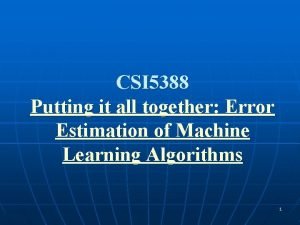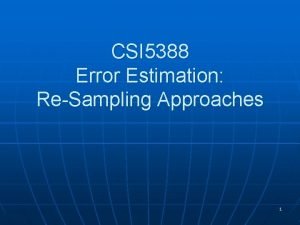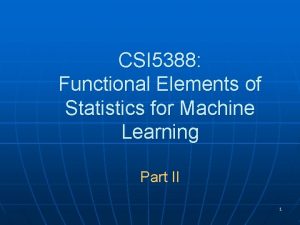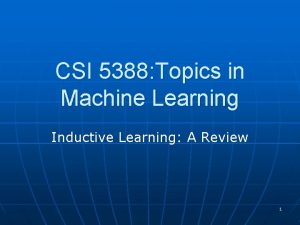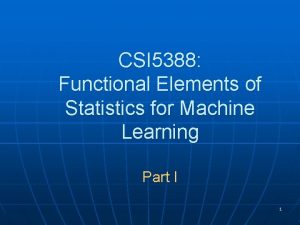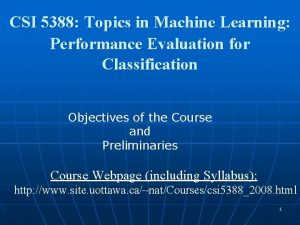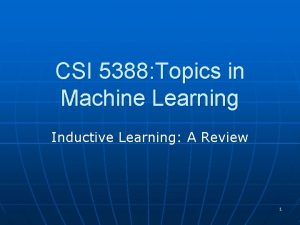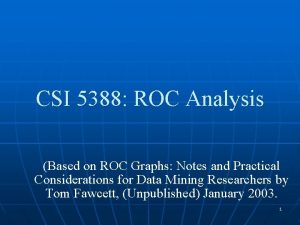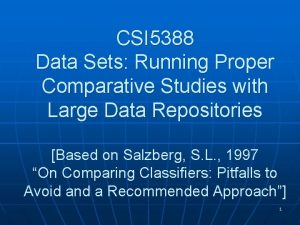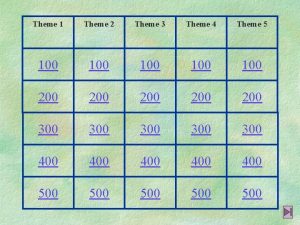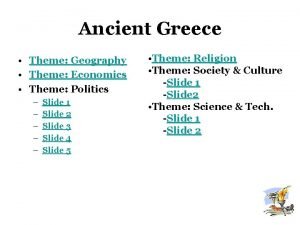ONECLASSIFICATION Theme presentation for CSI 5388 PENGCHENG XI
































- Slides: 32

ONE-CLASSIFICATION Theme presentation for CSI 5388 PENGCHENG XI Mar. 09, 2005

papers • D. M. J. Tax, One-classification; Conceptlearning in the absence of counter-examples, Ph. D. thesis Delft University of Technology, ASCI Dissertation Series, 65, Delft, 2001, June 19, 1190. • B. Scholkopf, A. J. Smola, and K. R. Muller. Kernel Principal Component Analysis. In B. Scholkopf, C. J. C. Burges, and A. J. Smola, editors, advances in Kernel Methods-SV learning , pp. 327 -352. MIT Cambridge, MA, 1999.

Difference (1)

Difference (2) • Only information of target class (not outlier class) are available; • Boundary between the two classes has to be estimated from data of only genuine class; • Task: to define a boundary around the target class (to accept as much of the target objects as possible, to minimizes the chance of accepting outlier objects)

Situations

Regions in one-classification (Tradeoff? )Using a uniform outlier distribution also means that when EII is minimized, the data description with minimal volume is obtained. So instead of minimizing both EI and EII, a combination of EI and the volume of the description can be minimized to obtain a good data description.

considerations • A measure for the distance d(z) or resemblance p(z) of an object z to target class • A threshold on this distance or resemblance • New objects are accepted: or

Error definition • A method which obtains the lowest outlier rejection rate, , is to be preferred. • For a target acceptance rate , the threshold is defined as:

ROC curve with error area (evaluation? )

1 -dimensional error measure • Varying thresholds along A to B: not on the basis of one single threshold, but integrates their performances over all threshold values

Characteristics of one-class approaches • Robustness to outliers: * when in a method only the resemblance or distance is optimized, it can therefore be assumed that objects near the threshold are the candidate outlier objects. * for methods where resemblance is optimized for a given threshold, a more advanced method for outliers should be applied in the training set.

Characteristics of one-class approaches (2) • Incorporation of known outliers: general idea: to further tighten the description • Magic parameters and ease of configuration: parameters have to be chosen beforehand as well as their initial values “magic” having a big influence on the final performance and no clear rules are given how to set them

Characteristics of one-class approaches (3) • Computation and storage requirements: training is often done off-line training costs are not that important to adapt to changing environment training costs are important

Three main approaches • Density estimation Gaussian model, mixture of Gaussians and Parzen density estimators • Boundary methods k-centers, NN-d and SVDD • Reconstruction methods k-mean clustering, self-organizing maps, PCA and mixtures of PCA’s and diabolo networks

Density methods • Straightforward method: to estimate the density of the training data and to set a threshold on this density • Advantageous when: a good probability model is assumed; and the sample size is sufficient • Rule of accepting: By construction, only the high density areas of the target distribution are included

Density methods Gaussian model

Gaussian model (2) • Probability distribution for a ddimensional object x is given by: • Insensitivity to scaling of the data: utilizing the complete covariance structure of the data • Another advantage: computing the optimal threshold for a given :

Density methods Mixture of Gaussians • Due to strong requirements of the data: unimodal and convex • To obtain a more flexible density model: a linear combination of normal distributions • Number of Gaussians is defined beforehand; means and covariance can be estimated

Density methods Parzen density estimation • Also an extension of Gaussian model: equal width h in each feature direction means to assume equally weighted features and thus to be sensitive to the scaling of the feature values of the data • Cheap training cost, but expensive testing cost: all training objects have to be stored and distances to all training objects have to be calculated and sorted

Boundary methods K-centers • General idea: covers the dataset with k small balls with equal radii • To minimize: (maximum distance of all minimum distances between training objects and the centers)

Boundary methods NN-d • Advantages: avoids density estimation and only uses distances to the first nearest neighbor • Local density is estimated by: a test object z is accepted when: its local density is larger or equal to the local density of its nearest neighbor in the training set

Support Vector Data Description • To minimize structural error: with the constraints:

Polynomial VS Gaussian kernel

Prior knowledge in reconstruction • reconstruction method: In some cases, prior knowledge might be available and the generating process for the objects can be modeled. When it is possible to encode an object x in the model and to reconstruct the measurements from this encoded object, the reconstruction error can be used to measure the fit of the object to the model. It is assumed that the smaller the reconstruction error, the better the object fits to the model.

Reconstruction methods • Most of the methods make assumptions about the clustering characteristics of the data or their distribution in subspaces • A set of prototypes or subspaces is defined and a reconstruction error is minimized • Differs in: definition of prototypes or subspaces, reconstruction error and optimization routine

K-means • Assume that data is clustered and can be characterized by a few prototype objects or codebook vectors • Target objects are represented by the nearest prototype vector measured by Euclidean distance • Placing of prototypes is optimized by minimizing the error:

K-means V. S. K-center • K-center: focus on worst-case objects • K-means: more robust to remote outliers

Self-Organizing Map (SOM) • Placing of prototypes is optimized with respect to data, and constrained to form a low-dimensional manifold • Often a 2 - or 3 -dimensional regular square grid is chosen for this manifold • Higher dimensions are possible, but expensive storage and optimization costs

Principal Component Analysis • Used for data distributed in a linear subspace • Finds the orthonormal subspace which captures the variance in the data as best as possible • To minimize the square distance from the original object and its mapped version:

Kernel PCA • Can efficiently compute principal components in high-dimensional feature spaces, related to input space by some nonlinear map • Indistinguishable problems in original spaces can be distinguished in mapped feature space with the map • The map need not to be obviously defined because of inner products can be reduced to kernel functions

Auto-encoders and Diabolo networks auto-encoder network (bottleneck layer) diabolo network

Auto-encoders and Diabolo networks • Both are to reproduce the input patterns at their output layer • Differs in: number of hidden layers and the sizes of the layers • Auto-encoder tends to find a data description which resembles the PCA; while small number of neurons in the bottleneck layer of the diabolo network acts as an information compressor • When the size of this subspace matches the subspace in the original data, the diabolo network can perfectly reject objects which are not in the target data subspace
 Fspos vägledning för kontinuitetshantering
Fspos vägledning för kontinuitetshantering Typiska novell drag
Typiska novell drag Tack för att ni lyssnade bild
Tack för att ni lyssnade bild Ekologiskt fotavtryck
Ekologiskt fotavtryck Varför kallas perioden 1918-1939 för mellankrigstiden
Varför kallas perioden 1918-1939 för mellankrigstiden En lathund för arbete med kontinuitetshantering
En lathund för arbete med kontinuitetshantering Personalliggare bygg undantag
Personalliggare bygg undantag Personlig tidbok
Personlig tidbok Sura för anatom
Sura för anatom Förklara densitet för barn
Förklara densitet för barn Datorkunskap för nybörjare
Datorkunskap för nybörjare Boverket ka
Boverket ka Tes debattartikel
Tes debattartikel Autokratiskt ledarskap
Autokratiskt ledarskap Nyckelkompetenser för livslångt lärande
Nyckelkompetenser för livslångt lärande Påbyggnader för flakfordon
Påbyggnader för flakfordon Lufttryck formel
Lufttryck formel Offentlig förvaltning
Offentlig förvaltning Jag har gått inunder stjärnor text
Jag har gått inunder stjärnor text Presentera för publik crossboss
Presentera för publik crossboss Teckenspråk minoritetsspråk argument
Teckenspråk minoritetsspråk argument Kanaans land
Kanaans land Klassificeringsstruktur för kommunala verksamheter
Klassificeringsstruktur för kommunala verksamheter Fimbrietratt
Fimbrietratt Bästa kameran för astrofoto
Bästa kameran för astrofoto Cks
Cks Programskede byggprocessen
Programskede byggprocessen Mat för unga idrottare
Mat för unga idrottare Verktyg för automatisering av utbetalningar
Verktyg för automatisering av utbetalningar Rutin för avvikelsehantering
Rutin för avvikelsehantering Smärtskolan kunskap för livet
Smärtskolan kunskap för livet Ministerstyre för och nackdelar
Ministerstyre för och nackdelar Tack för att ni har lyssnat
Tack för att ni har lyssnat


































